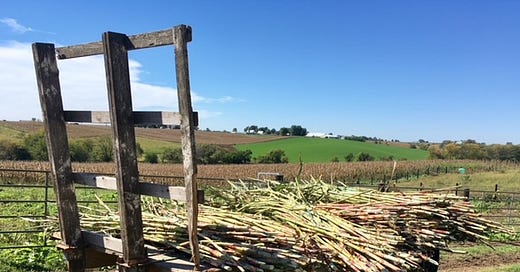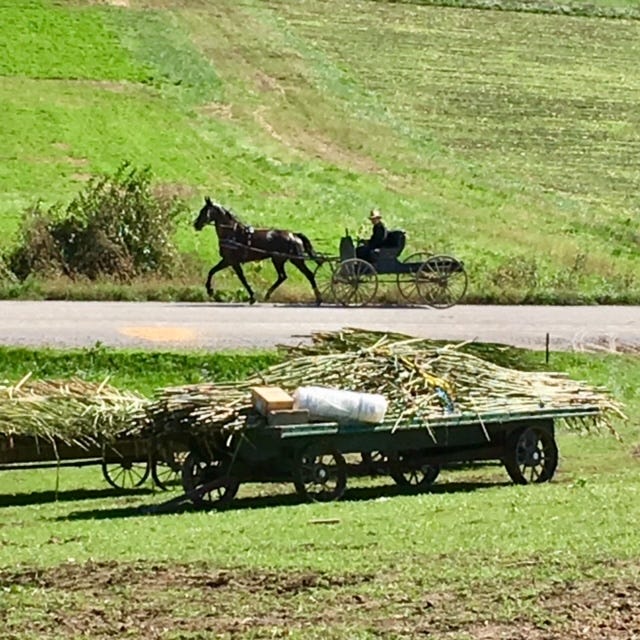My Amish neighbors never rest until the corn and beans are harvested and the last jar of sorghum is sealed and put on the shelf. In late fall, the Bontragers crank up their sorghum press and whistle themselves into business.
Toot-toooot.
The sound of the whistle and the creak of the steel wagon wheel rims on the gravel road are my first clues of the season. Some wagons are pulled by draft horses, the driver’s reins snapping across their taut bodies. Other wagons are pulled by antique tractors, their rubberless rims rattling along, making their own music in a cacophony of bumps, scrapes and moans. At this time of year, one by one the cornfields surrender, the land shaven clean, turned a golden brown. The last cutting of hay is pressed into squares or rolled up into large round bales. A few stubby corn stalks or stray ears of corn may be all that’s visible to the driver of a car bombing down the road.
But I have the pleasure of watching the sorghum harvest slowly unfold. One day, one wagon, then another, then another trundling along. Throughout late October and into November, the wagons make a steady procession, the cane piled high, tied down with long lengths of rope. Some stacks of cane are neat and tidy, others helter-skelter. Those Amish farmers who couldn’t be bothered with rope, throw their young boys spread-eagle on top of the cane. All headed just a mile down the road toward the Bontrager’s farm.
There, the Bontragers press sorghum cane for the entire neighborhood, the juice filtered, and then boiled down into a syrup.
“We’re getting our sorghum ready now,” the Yutzys told me a couple of weeks after Bertha’s passing. They were cutting their cane, then stripping the leaves and removing the heads, the seeds fed to the chickens. “We’d like to give you a gallon for all the errands you ran for us a few weeks ago.”
I gladly accepted this promised offer. This is how neighborliness works in Buggy Land. You help me out. I help you. I give you something for your trouble. You return the favor. Somehow, it all evens out.
I thought back to the old days when I first moved to this area. Then, the sorghum press was inside a rickety old wooden shed leaning into the wind, the roof covered with an odd assortment of shingles that looked like they may have been blown down the road from various houses in a tornado.
A horse was hitched to the press, walking around and around a track, creating the power to crush the cane and separate out the green liquid. Pencil marks on the wall kept count of how many wagonloads of cane each family brought to the press and how many jugs of sorghum they would ultimately receive. The children were sent out to the hill with shovels and buckets to bring back the clay for the filtration. The boiling took place in another old shed with a wood-fed fire. All day, one of the Bontrager teenagers threw big chunks of wood into a huge metal barrel to keep the fire going.
Once the sorghum was finished, poultry processing began. In the corner of the shed stood an old gas-powered wringer washing machine converted to a chicken pucker. Large rinsing tubs held ice that cooled the birds that would be slipped into plastic bags sealed with twist ties. The inspector wasn’t too keen on this whole operation, so the Bontragers were allowed to process their own birds, but not the neighbors’.
Over the years, the sorghum press became more sophisticated. A generator replaced the horse. Propane eventually replaced the wood fire. And a refractometer was purchased to test the sweetness of the juice. The small instrument that looks like a cross between a thermometer and an otoscope is used to measure the sugar content of the sorghum as it’s cooking. When the juice reaches the perfect temperature and sugar content—not too cool and green for fear of mold, and not too hot for fear of scald—it is removed from the boiler and poured into sterilized glass jars.
Dan, the Bontrager grossdaddy, was okay with these modernizations, but he wouldn’t let go of the sheds. They do fine, he said. We only use them a couple of weeks a year. They do just fine.
Then one season, suddenly, my Amish neighbor Sadie appeared at my door.
“We’re in a bit of an emergency,” Sadie said. “We’re in the middle of making sorghum and the refractometer has broken.”
I scurried over to the computer and tried to overnight a refractometer to their house. But alas, the one company who made the instrument, couldn’t get the thing to them in less than ten days.
I imagined this turn of events causing great stress, the Amish backed up on the road with their wagons filled with cane.
Instead, Sadie took the delay more calmly than I had predicted.
“I’ll go get Grandpa,” she said. “He can just dip his finger in the juice, taste it, and immediately know the sugar content.”
The refractometer arrived several weeks later after all the sorghum cane had been pressed. Then Dan, with a lifetime of knowledge of every aspect of farming and rural life, sadly departed that winter to the great beyond. By spring, the old sheds were gone and a large white barn went up.
The Bontrager farm straddles two counties, one with much stricter rules and regulations on chicken processing than the other. So, the Bontragers used the north end of the barn in the strict county for church, weddings, and buggy storage, and the south end in the more laissez-faire county for the sorghum press and chicken processing. The inspector had now sanctioned both activities as businesses.
A huge generator was placed outside, pumping power into the barn. The press has grown to three times its original size. Immaculately clean stainless steel industrial tables and tubs now hold the green juice before it's filtered to remove impurities. The juice is boiled in another sleek, stainless-steel piece of equipment, its gas flames kept at a constant temperature through adjustable valves.
Through a door, the poultry processing room contains individual stations–from the restraining cones, to the gutting, the plucking, washing and cooling, and bagging. The plucking machine is a massive steel drum, designed by the Bontragers themselves. The plucked feathers fall to the floor, sprayed down by a hose dropped from the ceiling. Then one of the family members squeegees the feathers out through a slot in the side of the wall where they drop to a compost bin. There, they are mixed with goat manure and eventually spread on the field.
The operation generates no waste. And the whistle was saved from the old shed, letting off a little steam, and a little more. It blows, then blows again. One night I heard the whistle blow until eleven o’clock P.M.
Toot-toooot.
The next morning, one of Bertha’s daughters stood on my front step with a gallon jug of sorghum in her hands.
Listen to Episode #54 of Mary Swander’s Buggy Land podcast. Includes “Here Lies Mary Swander,” “Once the Sky Had Cleared,” and “Gott Ist Die Liebe.”
Want to follow my events and activities, get links to my books and plays? Check out my website:
maryswander.com
I am thrilled to be part of the Iowa Writers Collaborative. Please support my colleagues by subscribing to and enjoying their columns in the Sunday Round-Up:








Your stories about Buggy Land are so rich. I feel like I am sitting on the front porch with you sharing the wonder! Thank you.
I love this stories and others you've shared about where real food comes from and how actual decisions are sometimes made--Grandpa gauging the sugar content with his finger!